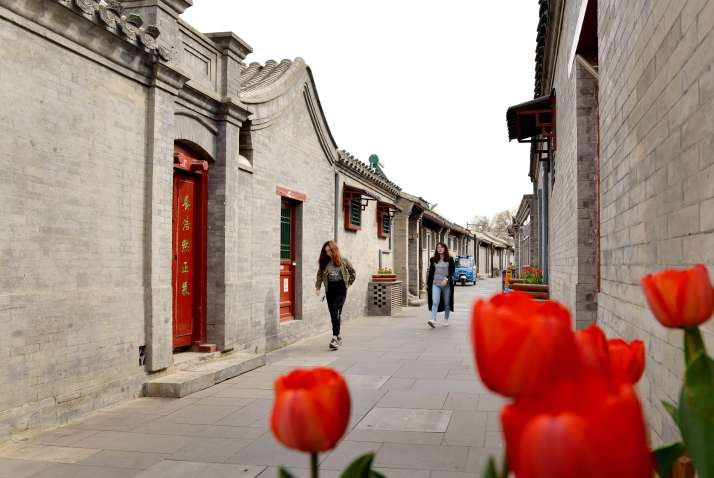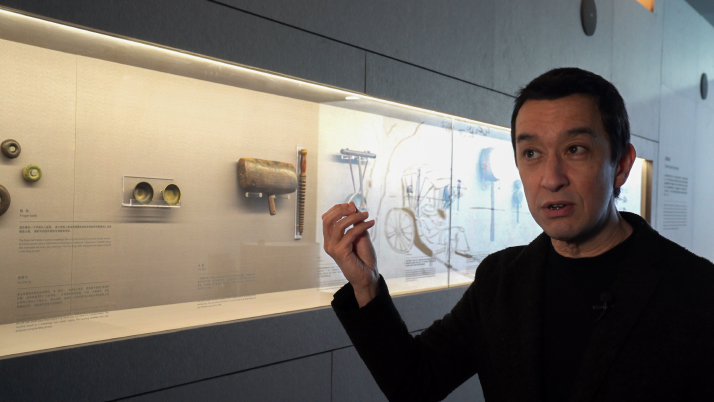| Lifestyle |
| A British artist's auditory journey connects Beijing's past and present | |
|
|
 People stroll at a hutong in Qianmen area in Beijing, April 6, 2019 (XINHUA)
Strolling through the hutongs, Beijing's network of traditional narrow alleyways, one can easily get lost in their unique history-laden atmosphere. Among the capital's thousands of old lanes, Shijia Hutong stands out for two reasons: its innate cultural value and the fact that it houses Beijing's first hutong museum. Walking into the alleyway's courtyard No.24, visitors are greeted with decorations reminiscent of the early 20th century. The 1,000-square-meter Shijia Hutong museum, which welcomed its first visitors in 2013, consists of eight exhibition rooms, with the displayed items showing hutong life as it was decades ago. The Memory of Time room holds more than 300 recordings capturing the sounds of old Beijing as curated by Colin Siyuan Chinnery, a British artist whose own family once upon a time happened to reside in this very courtyard. Born into a family of scholars, Chinnery has diverse life experiences: a child actor starring in a martial arts film, a computer science dropout from Scotland's Edinburgh University, a student at the School of Oriental and African Studies at the University of London, a fellow with the British Library, lead vocalist in a rock band… Despite all these experiences, he decided to settle down in the field of art. The sound of the city Being half-British and half-Chinese, Chinnery traced his roots back to Beijing, his mother's hometown, to conduct research on Chinese culture. "I was thinking of making a history of Beijing using only sound," Chinnery told Beijing Review. "Sound can take you back to a different time in your life, reminding you of feelings experienced in that particular moment. It's really like reliving the past with all your emotions," he said. This understanding came from a project he undertook in 2005, titled Sound and the City, which invited well-known artists from China and the United Kingdom to explore life's acoustic ecology. "What we did during this project was to ask people what their favorite sounds were, and then record them," he said. To his surprise, this one simple question led to a rich discussion about personal memory, urban change and even history. "The sounds people mentioned were mostly ambient sounds from the past, like the bell of the Telegraph Building (a landmark along Beijing's renowned Chang'an Avenue) or the chime of a taxi's meter; they were the sounds of society on the daily basis," Chinnery explained, adding, "It's natural for us to neglect them. Even if they disappear as the city develops, when we hear them, out of the blue, they can still trigger feelings of nostalgia." In the process of collecting the sounds, Chinnery realized many of Beijing's symbolic sounds, like the chants of street vendors hawking their wares and the sounds of the gongs candy vendors used to attract children while traveling from hutong to hutong, could only be heard in staged performances rather than in their original cultural environment. "Like a gong, each percussion instrument makes a specific kind of sound, and each sound is the epitome of a trade in old Beijing, which could be selling a craft, an object or a service. In the past, when hearing that particular sound, one immediately knew what it represented. These sounds were advertisements," Chinnery explained. Instead of purely recording the target sounds, Chinnery aimed to replicate the full-sphere surround sounds. So a challenge arose: locating the sources and filling in the blanks. For example, to collect the sound of camel bells, which used to indicate the arrival of winter in the capital—because the coals for heating were carried into the city by camel train, he rented a herd of camels and brought them into a large open space. "I could have shaken a camel bell myself in the studio, but I wanted to fully capture the subtle sounds in their entirety, like those of the animals breathing and their footsteps," he explained. "I collected and organized a lot of memorable sounds of Beijing this way, creating an ever-larger database of people's relationships with sound," Chinnery said. The Sound and the City project gave the artist the opportunity to communicate with many people: "Sound is immediate. It's about experience. It's about life itself. So if you frame it the right way and contextualize it the right way, you can speak to many people." Soon after the project had wrapped up, Chinnery realized simply recording sounds of the past was no longer enough for him. "As a contemporary artist, I am committed to the present moment, so I am exploring sound as a medium to create interesting projects, which can bridge the gap between the old days and contemporary society," he elaborated. "I think we have to be sensitive enough to the present to really face the future."  Colin Siyuan Chinnery introduces a range of percussion instruments, each of which carries a distinctive sound that epitomizes a specific trade in old Beijing, at Beijing's Sound Art Museum on November 15, 2022 (ZHANG WEI)
Located in the heart of downtown Beijing, next to Qianmen Street, a famous pedestrian street for shopping and sightseeing, the Dashilan area has a commercial history spanning more than 600 years. Today, it features an emerging commercial and cultural complex called Beijing Fun, a prime example of urban revitalization in the capital's ancient center. In 2018, Chinnery created an acoustic public art installation at this junction of history and modernity. The whole installation delivered a distinctively immersive and sensory experience: As people sat down on the public benches, the sounds of old Beijing's street vendors would swarm in from all directions, generating a surround-sound time-travel effect and engaging people in the dialogue with spatial history. "My project originated from the city so I wanted it to give back to the city. Our cities are becoming more and more functionality-oriented, and culture and life are becoming more and more separated. If we can pay more attention to the interesting sounds surrounding us, we might be able to better appreciate life's details," Chinnery said. A sound approach Chinnery's auditory journey has been an ever-evolving process. What Chinnery tries to construct is a sound archive. He is a co-founder of the Sound Art Museum, which is located in Songzhuang of Beijing's Tongzhou District, the capital's sub-center, and went into trial operation on February 5. His projects at the museum not only convey the sounds of old Beijing, but also the sounds of nature, dialects and music from different Chinese regions. He teamed up with scholars of ancient Chinese languages to reproduce the pronunciation of some extinct languages based on remaining manuscripts. "So far, we've figured out what several extinct languages used in areas of today's Xinjiang Uygur Autonomous Region sound like; and we've made them heard again." The sound archive can offer references for historical research. "I want to offer a new perspective for people to perceive the world—by hearing and listening," he said. (Print Edition Title: Surround Sound) Copyedited by Elsbeth van Paridon Comments to kangcaiqi@cicgamericas.com |
|
||||||||||||||||||||||||||||
|
